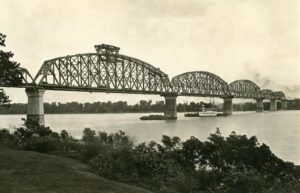
From 1895 until 1968, Big Four Bridge carried trains across the mighty Ohio River. The bridge is now a walking bridge. Image credit: Clark County Museum
According to historian Carl E. Kramer, several of Jeffersonville’s most prominent residents organized the Ohio & Indianapolis Railroad Company–soon renamed the Jeffersonville Railroad Company–in 1848. Kramer further notes that the first railroad line built from Jeffersonville connected the Ohio Valley with Columbus, Indiana by 1853. The switching yards occupied the site of Jeffersonville’s current library campus.
Prior to the development of rail travel, the rivers had served as the major arteries of transportation through the central North American continent. Railroads allowed quick access to places that once took days of overland travel to reach. As a result, small towns in Clark County and surrounding areas became easily accessible and grew in population once the railroads opened them to travelers.
With only the Ohio River separating Jeffersonville from the slave markets in Louisville, conflicts over the treatment of African Americans tinted many aspects of life in Clark County prior to the American Civil War. In 1854, an African American farmer from Henryville named Obediah Buckner challenged the Jeffersonville Railroad Company’s policy of requiring freedom papers from African Americans who wished to ride the rails. You can learn more about Buckner’s legal battle and the famous lawyer hired by the Jeffersonville Railroad Company here: https://publichistory.iupui.edu/items/show/560.
During the Civil War, Jeffersonville’s location along the mighty Ohio River made the Jeffersonville Railroad Company strategically important. Trains carried Union soldiers and supplies to Jeffersonville, where they could catch steamboats to Southern battlefields, according to Kramer. After the war, rail transportation became an important facet of American manufacturing.
The Ohio Falls Car & Locomotive Company began making railroad cars here in the 1870s, Kramer notes, and the Jeffersonville, Madison, & Indianapolis Railroad (J M & I RR) manufactured engines, including the Reuben Wells, the heaviest engine in the nation at the time of its construction in 1868. The Children’s Museum of Indianapolis houses the Reuben Wells in its basement. The famed Reuben Wells was named for the JM & I RR’s chief engineer.
In the twentieth century, American Car & Foundry carried on with rail car manufacturing well into the twentieth century. During World War II, specialized rail vehicles aided in the manufacture and transportation of the many military supplies manufactured in Clark County. The names of railway companies often changed as time went on, but even after the switching yard on Court Avenue became the library’s campus, railways remained an important part of Clark County’s industry, past, present and future.
Kramer, Carl. This Place We Call Home (Indiana University Press, 2007).
